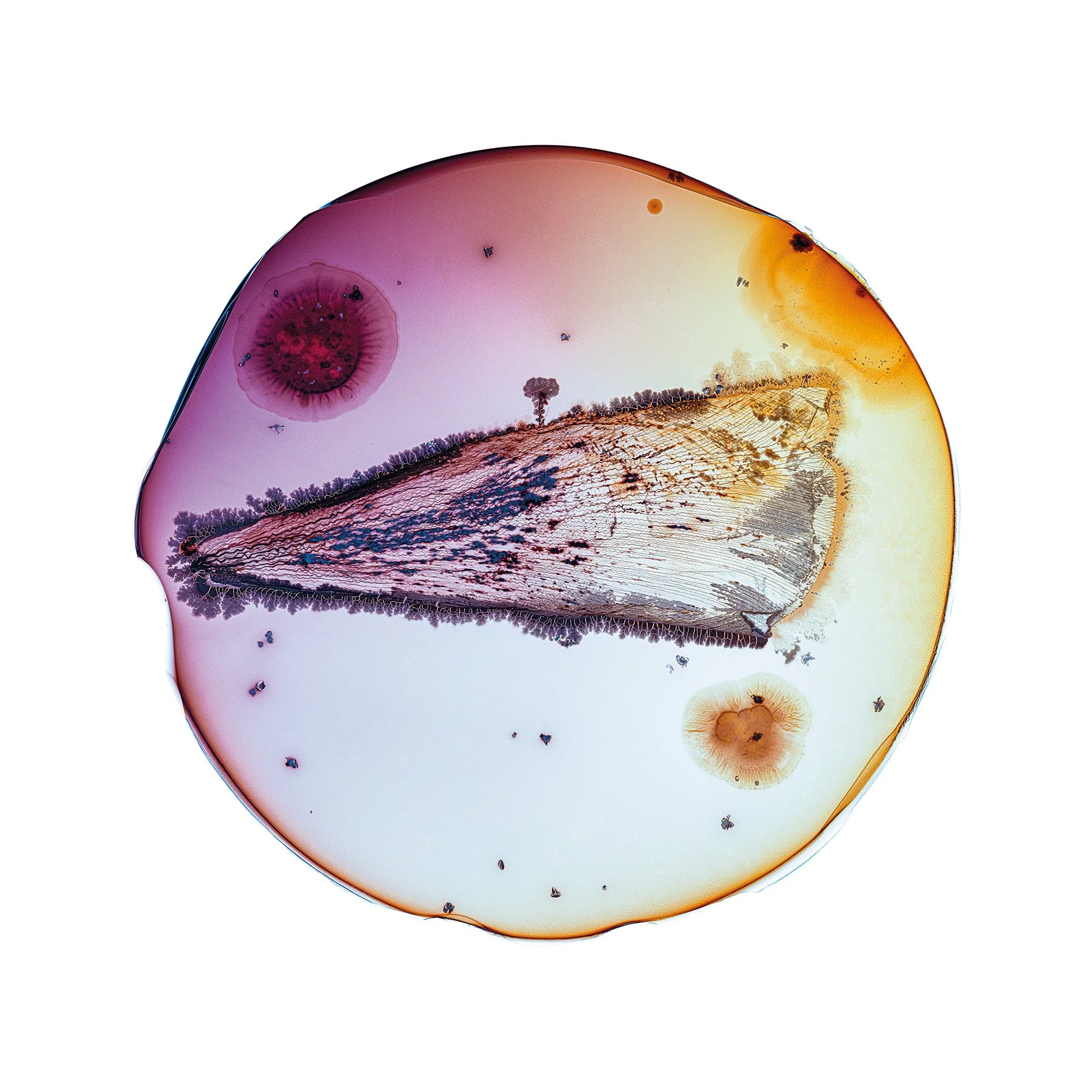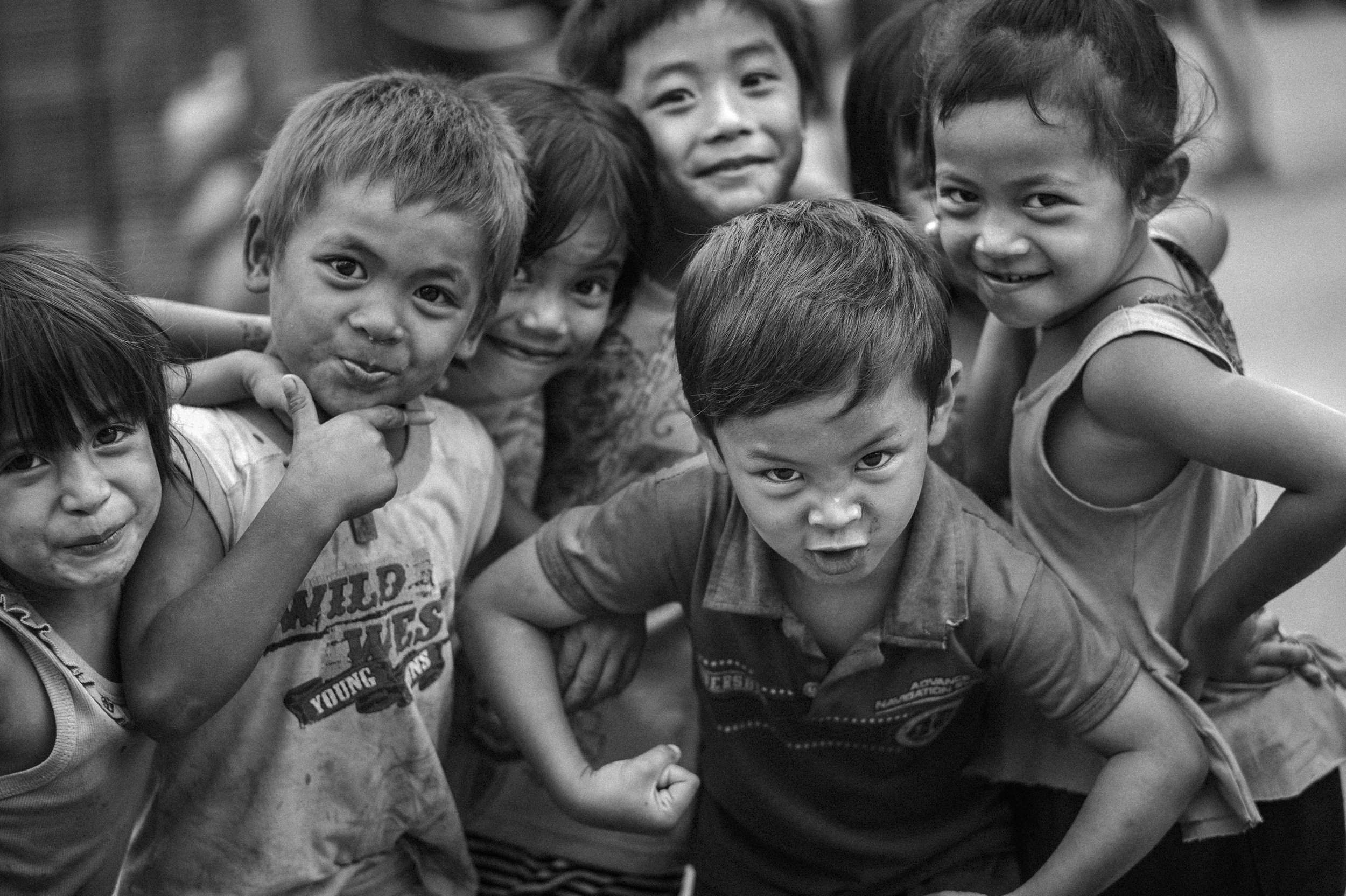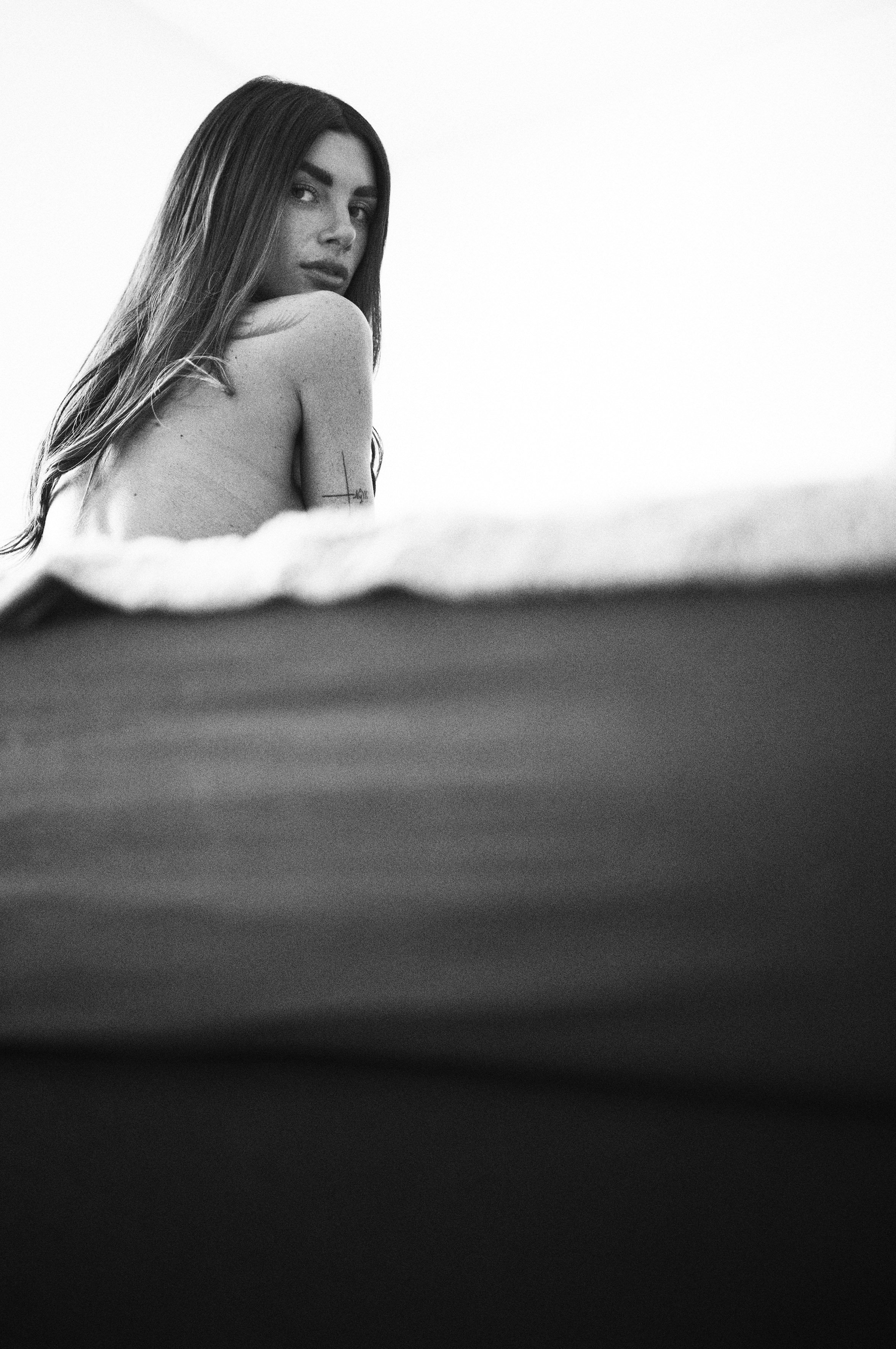
Kathrin Linkersdorff. Microverse | Stadthaus Ulm
Stadthaus Ulm
22. Juni - 21. September 2025
Kathrin Linkersdorff. Microverse
FairiesIV / 3, 2020 © Kathrin Linkersdorff / VG Bild-Kunst, Bonn 2025
Die Werke von Kathrin Linkersdorff eröffnen einen mikroskopischen Kosmos, in dem sich Kunst und Wissenschaft verschränken. Ihre Fotografien zerstörter Blüten und bakterieller Prozesse stellen das Unsichtbare ins Zentrum – ein poetischer Blick auf Vergänglichkeit, Wandel und die Ästhetik des Verfalls.
Im Stadthaus Ulm zeigt Kathrin Linkersdorff mit «Microverse» Arbeiten, die das fragile Wechselspiel von Natur und Wissenschaft in grossformatigen Fotografien verhandeln. Bekannt wurde die in Berlin lebende Künstlerin durch experimentelle Herangehensweisen: In monatelang angelegten Versuchsanordnungen setzt sie florale Zerfallsprozesse gezielt in Gang. Mit botanischem und mikrobiologischem Wissen legt Linkersdorff die innersten Strukturen von Blüten frei und hält deren Transformationen in opulent inszenierten Aufnahmen fest.
Die meditative Stille dieser Kompositionen ist dem japanischen Wabi Sabi verpflichtet – ein Schönheitsbegriff, der Unvollkommenheit und Vergänglichkeit nicht negiert, sondern als integralen Teil ästhetischer Erfahrung begreift. Besonders ihre Serie «Fairies» inszeniert diesen Gedanken: Linkersdorff entzieht Tulpenblüten behutsam die Pigmente, lässt sie trocknen und dokumentiert im Wasser schwebend ihr transparentes Skelett. Mitunter fliessen die extrahierten Farbstoffe zurück ins Bild – ein Moment malerischer Rückeroberung, der Leben und Sterben in einen poetischen Dialog treten lässt.
In ihrer neuen Werkgruppe «Microverse», entstanden in Kooperation mit der Mikrobiologin Prof. Regine Hengge, rückt die Künstlerin die faszinierende Dynamik bakterieller Lebenswelten in den Fokus. Entfärbte Pflanzenteile werden zum Nährboden für Bakterienkulturen, deren Wachstum und zelluläre Stoffwechselprodukte – farbige Antibiotika – vor der Kamera sichtbar werden. Was als biologischer Prozess beginnt, verwandelt sich durch Linkersdorffs sensible fotografische Inszenierung in malerische Farblandschaften, die das Werden und Vergehen als Symphonie der Elemente sichtbar machen.
Kathrin Linkersdorffs Werk öffnet ungewohnte Perspektiven auf eine Natur, deren Mikrokosmen wir im Alltag selten wahrnehmen. Ihre Verbindung von prozesshafter Bildgenese, wissenschaftlichem Erkenntnisinteresse und stiller Schönheit offenbart das Unsichtbare hinter dem Sichtbaren – und einen Zugang zu den grossen Fragen nach Zeit, Transformation und der conditio humana.
MicroverseII / 1, 2023 © Kathrin Linkersdorff / VG Bild-Kunst, Bonn 2025
Les œuvres de Kathrin Linkersdorff révèlent un microcosme où art et science s’entrelacent. Ses photographies de fleurs en décomposition et de processus bactériens placent l’invisible au centre – une réflexion poétique sur l’impermanence, la transformation et l’esthétique de la disparition.
Au Stadthaus Ulm, Kathrin Linkersdorff présente « Microverse », une exposition qui explore, à travers de grandes photographies, l’interaction fragile entre la nature et la science. Artiste berlinoise de renom, elle s’est fait connaître par ses approches expérimentales : des installations élaborées sur plusieurs mois où la décomposition florale devient un laboratoire d’exploration. Par un dialogue fertile entre botanique et microbiologie, Linkersdorff révèle l’intimité structurelle des fleurs et immortalise leurs mutations dans des compositions soigneusement orchestrées.
Le calme méditatif de ces images s’inspire du concept japonais du Wabi Sabi, une philosophie qui voit dans l’imperfection et l’éphémère la source de toute beauté. C’est dans sa série « Fairies » que ce principe s’incarne avec le plus d’évidence : Linkersdorff extrait délicatement les pigments de pétales de tulipes, les laisse sécher, et immortalise leurs squelettes transparents, flottant dans l’eau. Parfois, les pigments retrouvés s’infusent à nouveau dans la composition – moment pictural où vie et disparition entrent en dialogue poétique.
Avec sa récente série « Microverse », née de la collaboration avec la microbiologiste Prof. Regine Hengge, l’artiste explore le dynamisme fascinant du monde bactérien. Des fragments végétaux décolorés deviennent le substrat pour des colonies bactériennes, dont la croissance et la production de colorants – des antibiotiques naturels – se révèlent devant l’objectif. Ce qui commence comme un procédé biologique se transforme, grâce à la sensibilité photographique de Linkersdorff, en paysages colorés, où la genèse et la disparition s’expriment dans une véritable symphonie élémentaire.
L’œuvre de Kathrin Linkersdorff ouvre des perspectives inédites sur une nature dont les microcosmes demeurent souvent invisibles au quotidien. Sa fusion du processus créatif, de la rigueur scientifique et de la beauté contemplative met à nu l’invisible au sein du visible, tout en offrant un accès sensible aux grandes questions du temps, de la transformation et de la condition humaine.
Fairies I / 1, 2020 © Kathrin Linkersdorff / VG Bild-Kunst, Bonn 2025
Le opere di Kathrin Linkersdorff aprono un microcosmo in cui arte e scienza si intrecciano. Le sue fotografie di fiori disfatti e processi batterici pongono al centro ciò che è invisibile – uno sguardo poetico sulla caducità, la trasformazione e l’estetica della dissoluzione.
Nello Stadthaus Ulm, Kathrin Linkersdorff propone con «Microverse» una riflessione sulle delicate relazioni tra natura e scienza in fotografie di grande formato. Nata a Berlino, l’artista si è imposta grazie a un approccio sperimentale: complessi esperimenti di mesi in cui i processi di decadimento floreale vengono attivamente avviati. Unendo botanica e microbiologia, Linkersdorff mette a nudo le strutture più intime dei fiori, immortalando le loro trasformazioni in immagini accuratamente composte.
La quiete meditativa di queste composizioni affonda le radici nel Wabi Sabi giapponese, concetto che riconosce nella caducità e nell’imperfezione il cuore stesso della bellezza. Nella serie «Fairies» questo pensiero diventa visibile: Linkersdorff priva delicatamente i petali di tulipano dei pigmenti, li lascia essiccare e fotografa i loro scheletri trasparenti nell’acqua. A volte, i pigmenti estratti vengono reintrodotti nell’immagine – un istante pittorico in cui vita e morte entrano in dialogo poetico.
Nel nuovo ciclo «Microverse», nato in collaborazione con la microbiologa Prof.ssa Regine Hengge, l’attenzione si sposta sugli affascinanti mondi batterici. Parti vegetali decolorate diventano substrato nutritivo per colonie batteriche, la cui crescita e la produzione di antibiotici colorati vengono immortalate dall’obiettivo. Quello che nasce come processo biologico si tramuta, attraverso la sensibilità fotografica dell’artista, in paesaggi cromatici che rendono visibili genesi e dissoluzione come una sinfonia della natura.
L’opera di Kathrin Linkersdorff apre prospettive inedite su una natura i cui microcosmi ci rimangono per lo più nascosti. L’intreccio di creazione procedurale, curiosità scientifica e bellezza silenziosa rivela ciò che normalmente resta invisibile, invitandoci a riflettere sul tempo, la trasformazione e la condizione umana.
MicroverseIII / 2 / Sc-M510 / 19.6.-25.7.24, 2025 © Kathrin Linkersdorff / VG Bild-Kunst, Bonn 2025
Kathrin Linkersdorff’s works open up a microscopic universe where art and science interlace. Her photographs of decaying blossoms and bacterial processes place the invisible at the centre—a poetic meditation on transience, transformation, and the aesthetics of decay.
At Stadthaus Ulm, Kathrin Linkersdorff’s “Microverse” presents large-scale works that explore the delicate interplay between nature and science. The Berlin-based artist, renowned for her experimental approach, orchestrates month-long experiments wherein she deliberately initiates the decomposition of flowers. Drawing upon botanical and microbiological expertise, Linkersdorff uncovers the innermost structures of blossoms, capturing their transformations in lavish photographic compositions.
The contemplative quietude pervading these images owes much to the Japanese philosophy of Wabi Sabi, which finds beauty in imperfection and ephemerality. Nowhere is this sensibility more apparent than in her “Fairies” series: Linkersdorff meticulously removes pigments from tulip petals, dries them, then photographs their transparent skeletons suspended in water. At times, the extracted pigments are reintroduced into the image—an act that sees life and loss engage in a painterly, poetic exchange.
Her latest body of work, “Microverse,” was developed in collaboration with microbiologist Professor Regine Hengge. Here, the focus shifts to the enthralling dynamism of bacterial worlds. Discoloured plant fragments become nutrients for bacterial colonies whose growth and production of colourful antibiotics are documented before the camera. What begins as a biological process is, through Linkersdorff’s sensitive photographic artistry, transformed into painterly colour fields that render becoming and dissolution as an elemental symphony.
Kathrin Linkersdorff’s oeuvre offers rare perspectives on a natural world whose microcosms all too often elude everyday perception. Her fusion of procedural creation, scientific curiosity and a contemplative aesthetic brings the invisible within reach, opening a window onto questions of time, transformation, and the human condition.















































































